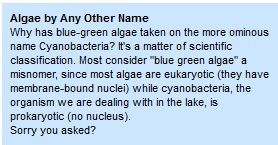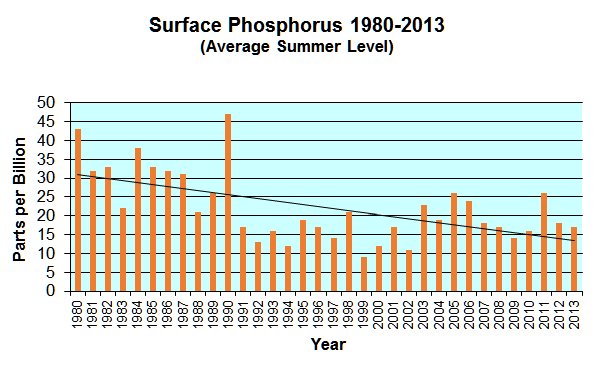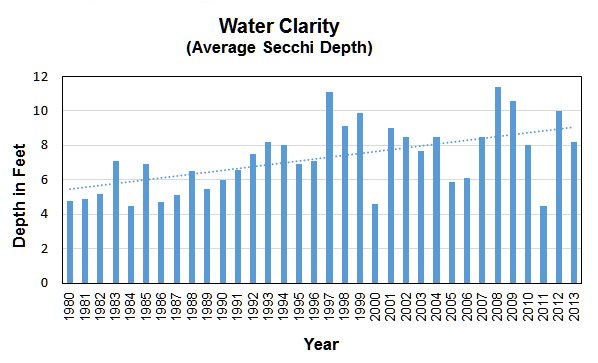2013 Annual Report: Clarifying Strategies and a Gathering Storm
The 2013 Annual Summary Report to the Task Force was prepared by the LWTF limnologist and chief scientific advisor Dr. Robert Kortmann and delivered on March 20, 2014.
The report suggests a course adjustment for LWTF priorities with respect to phosphorus and water clarity, and provides some positive feedback on relatively new in-lake strategies during spring and fall. In addition, it focuses our attention on an evolving threat which has affected other lakes in the region and has drawn increased scrutiny from the scientific community and the state: the release of toxins during the die-off stage of cyanobacteria (often called blue-green algae).
Water clarity and reduced concentrations of phosphorus have exhibited a close correlation over the years, in Lake Waramaug (see charts, right) and elsewhere. Trend lines for these measurements (Secchi disc readings and Total Surface Phosphorus) have, despite occasional anomalies, shown steady improvement and have provided the Task Force with the best testimony to the success of our work. However there has been a subtle shift in emphasis from maximizing to optimizing water clarity. It is believed that maintaining water clarity at a level of 6 to 8 feet (one-half the thickness of the epilimnion, or top warm thermal layer) is ideal for recreational lake activities and transmits some needed light to the metalimnion (mid-level) while providing a less suitable environment for algae and some non-native invasive plants.
Recent experimentation with early spring and fall activation of the in-lake layer aeration systems have shown positive results. In the spring, water circulation is used to enhance the diatom habitat. This may actually sacrifice some clarity temporarily, while delaying and reducing the growth of blue-green algae (cyanobacteria) later in the season. In the fall, layer aeration is used to take iron from the hypolimnion (lower depths of the lake), which when oxidized can bind to and remove phosphorus from the upper levels.
The report's cautionary note involves blue-green algae or cyanobacteria (inset, left) which has been observed to release toxins as it dies off. These toxins can cause serious illness in humans and animals, and the Connecticut DEEP and Department of Health have established guidelines for shutting down public beaches when concentrations are high. Connecticut was the last of the New England states to address this issue. Remarkably, there are no local laboratories capable of doing the required tests. Shipping samples elsewhere can be time-consuming. Hopefully, these testing problems are temporary.
The good news is that Lake Waramaug's cyanobacteria levels have been consistently well below the danger threshold, due in large part to our long-term efforts to reduce phosphorus. But this recent focus on cyanobacteria toxins requires increased vigilance.







